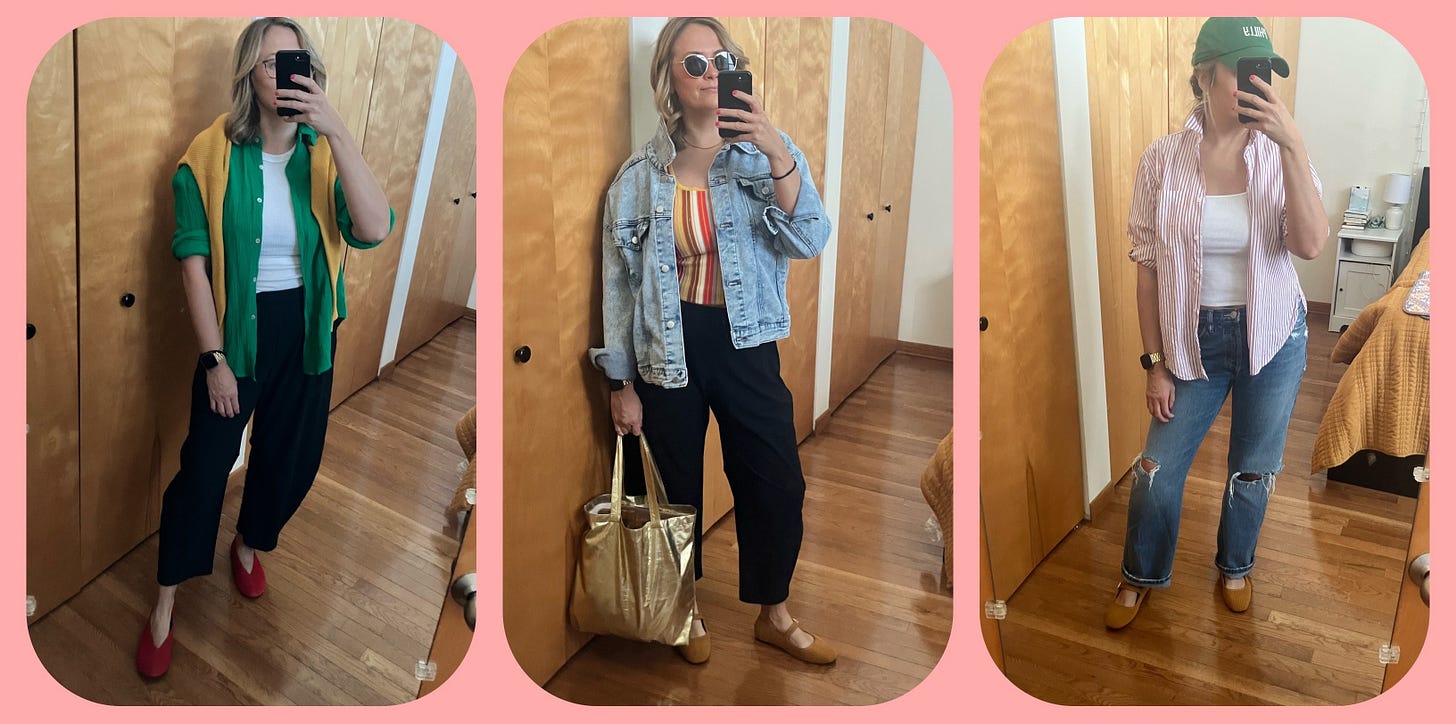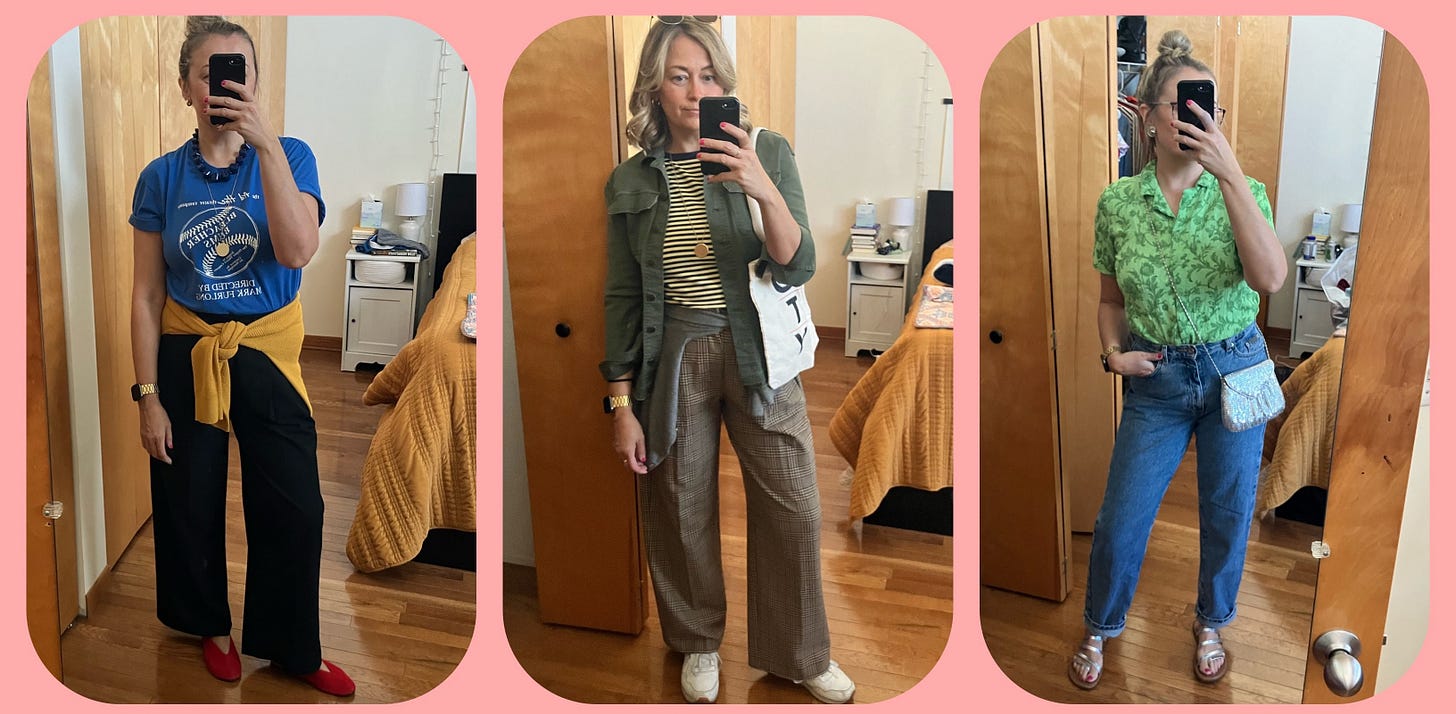1/Reading & Wearing: Food for Thought
a book about the mindset of cooking and how it applies to life (plus, May outfits)
Hello friends! Welcome to a monthly feature in which I share a book (or two, or three, or seven) and outfits I’ve loved, and uncover ways they inspired each other.
Food writing is one of my favorite non-fiction genres (nestled snuggly alongside self-help, writing guides, and narrative journalism). And it wasn’t until I read An Everlasting Meal by Tamar Adler (during a visit to one of my favorite bookstores Three Lives, whose newsletter is refreshingly old school, like receiving an email from a well-read friend in the early 2000’s) that I understood this genre, too, is a form of self-help: a user’s manual of sorts. After all, cooks are creators and teachers. What else is a recipe than a guide for bringing an idea to life?
Adler’s book centers around the interconnectivity of life and food, and how in both cases, the choices we make today inform the ones we make tomorrow. Her writing is as much about cooking as it is about the mindset we can have to better build a lasting relationship. With chapters like “How to Light a Room” (in which she likens adding herbs to “lighting candles to change the atmosphere”), and “How to Find Fortune” (an ode to turning underestimated vegetables into a thing of beauty), Adler eschews pretense and rigidity and instead, encourages readers to embrace the most important ingredient of all: self-trust.
She writes like a tough teacher speaks to students in whom she sees potential: simply, directly, and with a reminder that they already have what they need if they’re willing to show up and try. “We don’t need to be professionals to cook well…we don’t need to shop like chefs or cook like chefs; we need to shop and cook like people learning to cook, like what we are–people who are hungry”.
There’s an implicit confidence and surety instilled in this approach. Knowing ourselves better—remembering what we want to eat, unpacking the components of the flavors we like, engaging and familiarizing ourselves with what’s already in our kitchens—can better inform and empower what comes next. It can inform how we approach life.
“When we cook things, we transform them,” Adler says. “And any small acts of transformation are among the most human things we do. Whether it’s nudging dried leaves around a patch of cement, or salting a tomato, we feel, when we exert even tiny bits of our human preference in the universe, more alive.”
Line up tiny bits of preference like beads on a necklace and they can shift a nebulous day into one of meaning and memory. But when life becomes challenging, these choices can appear out of reach, even though this is when we need them most. As dusk descends on a day of back-to-back obligations, the act of scrambling eggs with gouda cheese and sun-dried tomatoes in my sun-drenched kitchen can feel holy. Same with bringing along my threadbare college t-shirt to slip into each night during a stressful work trip. Or hearing the haunting comfort of synth tones from Stranger Things Season Three playing for the nineteenth time when I’m nostalgic for the yawning days of high school Summers, surrounded by childhood friends at my hometown pool. Even writing this list out makes me emotional; it makes me want to care for myself more delicately. It reminds me of the simple sacredness of being human.
A closet and a kitchen. Both rife for personal preferences. Both filled with opportunities for creativity and boredom. These spaces (and perhaps all spaces we consistently inhabit) require a certain amount of ongoing personal interaction if they are to support and sustain us. If we’re constantly turning to ease (in a time when consumption takes mere seconds and doesn’t even require us touching our wallets) over engagement, we miss a chance to better understand and appreciate what we already have. So many outfits I pulled together in May included items I’d overlooked for weeks, simply because I allowed myself to spend more time considering them in new ways. We all have this type of white noise in our closets and our kitchens. How easy is it to just ignore it or add something new, only for that new item to lose its shine mere weeks later?

Embracing the belief that we can work with what we have (and in fact, work skillfully, with the space to practice and make mistakes) creates an energy shift from restriction to expansion, from punishment to play. Instead of freezing when we discover we don’t have an ingredient for a recipe (or a specific clothing match from an outfit we see online), we can use it as an opportunity for greater understanding of ourselves and our space. We can ask that great un-locker question: what if? What if I wore that dress as a top? What if I dug out that necklace from college? What if I wore that sweater backwards? What if I love it? What if I hate it? What if figuring out those dividing lines for ourselves (vs. relying on someone else to tell us) is the point?

Adler closes the intro of the book with an invitation:
“This is my attempt to hand over what I think matters. Then, whether you are hungry or anxious or curious, you can at least weed through and decide what seems right. I only mean to show what cooking is: an act of gathering in and meting out, a coherent story that starts with the lighting of a burner, the filling of a pot, and keeps going as long as we like. So, our end I think is clear. If our meal will be ongoing, then our only task is to begin.”
Here’s to more intention in our daily beginnings. May they nurture the type of ongoing habits that feed us.
Thank you for reading the Brooke Report. Exciting regular features are coming soon, like a peek inside my style crushes’ wardrobes, a look at the daily routines of creative thinkers, and reviews of bars+books (a perfect pairing). If you’d like to request any specific content, please email or let me know in the comments. I’m so grateful you’re here!








Surrounded by my friends at my hometown pool 🥰🥰🥰
Love your outfits (per usual), added the book to my list and subscribed to the bookstore’s newsletter.